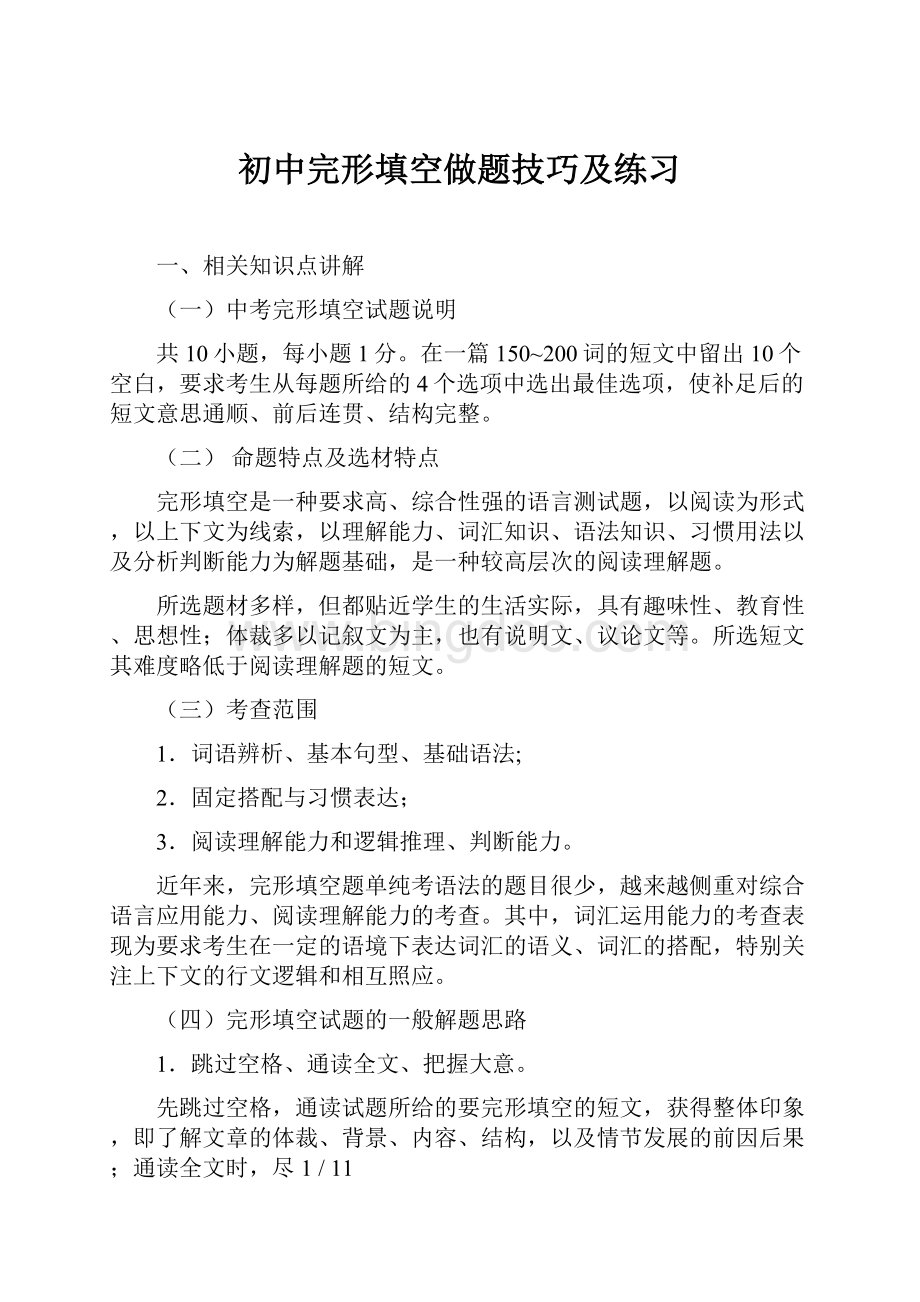初中完形填空做题技巧及练习.docx
《初中完形填空做题技巧及练习.docx》由会员分享,可在线阅读,更多相关《初中完形填空做题技巧及练习.docx(13页珍藏版)》请在冰点文库上搜索。

初中完形填空做题技巧及练习
一、相关知识点讲解
(一)中考完形填空试题说明
共10小题,每小题1分。
在一篇150~200词的短文中留出10个空白,要求考生从每题所给的4个选项中选出最佳选项,使补足后的短文意思通顺、前后连贯、结构完整。
(二)命题特点及选材特点
完形填空是一种要求高、综合性强的语言测试题,以阅读为形式,以上下文为线索,以理解能力、词汇知识、语法知识、习惯用法以及分析判断能力为解题基础,是一种较高层次的阅读理解题。
所选题材多样,但都贴近学生的生活实际,具有趣味性、教育性、思想性;体裁多以记叙文为主,也有说明文、议论文等。
所选短文其难度略低于阅读理解题的短文。
(三)考查范围
1.词语辨析、基本句型、基础语法;
2.固定搭配与习惯表达;
3.阅读理解能力和逻辑推理、判断能力。
近年来,完形填空题单纯考语法的题目很少,越来越侧重对综合语言应用能力、阅读理解能力的考查。
其中,词汇运用能力的考查表现为要求考生在一定的语境下表达词汇的语义、词汇的搭配,特别关注上下文的行文逻辑和相互照应。
(四)完形填空试题的一般解题思路
1.跳过空格、通读全文、把握大意。
先跳过空格,通读试题所给的要完形填空的短文,获得整体印象,即了解文章的体裁、背景、内容、结构,以及情节发展的前因后果;通读全文时,尽1/11
量避免文章空格的影响,初步搞清文章的大概意思即可。
不要纠缠于一句话、一个空,否则会断章取义,进入误区。
(时间:
3分钟)
2.结合选项、综合考虑、初定答案。
在理解全文意思的基础上,再结合所给备选项细读全文,联系上、下文内容,注意从上、下文的语法结构和词语搭配及从选择项中寻找解题的提示,以词、句的意义为先,再从分析句子结构入手,根据短文意思、语法规则、词语固定搭配等进行综合考虑,对备选项逐一进行分析、比较和筛选,排除干扰项、初步选定答案。
3.瞻前顾后、先易后难、各个击破。
动笔时要瞻前顾后、通篇考虑、先易后难。
对比较明显直接的、自己最有把握的答案先做,一下子不能确定答案的,先跳过这一空格,继续往下做,最后回过头来再集中精力解决难点。
这时可结合已确定答案的选项再读一遍短文,随着对短文理解的深入,可以降低试题的难度,提高选择的正确率。
4.复读全文、逐空验证、弥补疏漏。
完成各道题选择后,把所选的答案代入原文,再把全文通读一篇,逐空认真复查。
看所选定的答案是否使短文意思前后连贯、顺理成章,语法结构是否正确,是否符合习惯表达法。
如发现错误答案或有疑问的,应再次推敲、反复斟酌、做出修正。
(五)完形填空的设空规律有哪些
中考完形填空抛弃了传统的“语法知识型”命题模式,转变成“情境能力型”的命题趋势。
它的一个显著特点就是突出语篇,即重在文意的干扰,把具体的语言知识融进具体的语言情境中去,考查学生通过上下文对整体文意进行把握的能力。
1.从文章结构看
(1)首句通常不设空,以便考生对短文前提和背景有个较清楚的了解,从而使考生尽快熟悉语境、推测文章大意。
2/11
(2)短文设空平均密度为25个单词一个空。
2.从语言层次看
考点设计对把握语段的要求在提高。
我们可以把考点分为三个层次,即句子层次、句群层次和语篇层次。
(1)句子层次的设空
指那些只需读懂设空所在句便可选出答案的题目。
(2)句群层次的设空
指根据上下文的内容,经过推理判断可以得到答案的题目。
前制性设空
例:
ItwasanEnglishspeechcontest.Mymotheraskedmetotakepartinit.Whata
terribleidea!
ItmeantIhadto____infrontofalltheteachersandstudentsofmy
school!
A.writeB.speakC.singD.dance
后制性设空
例:
1).Nobody____himinthevillage.Onedayhesaidtothem,“Iknowyoudon't
likeme…”
A.believedB.likedC.hatedD.knew
A.manyB.allC.twoD.three
3.语篇性设空
3/11
Iworkasavolunteerforanorganizationthathelpsthepoorin.RecentlyItook
mysonBarrettthereforaweek,hopingto1him…achievedallI'dexpected.
Soonhewillcelebratehis18thbirthday.Hewillbeaman.(最后一句话)
(六)作答时应注意的几个问题
1.完形填空的短文通常没有标题,且文章的首句和尾句一般不设空,要特别注重对首、尾句的理解,因为它们往往提示或点明文章的主题,对理解全文有较大帮助。
2.第一遍通读带有空缺单词的短文时可能一时把握不住短文内容,弄不清头绪,这是很正常的。
此时要注意克服畏难情绪和急躁心理,应稳定情绪,再将短文
一、二遍,直到明确大意为止。
3.做题时切勿一看到一个空格就急着选出一个答案,这样往往只见树木不见树林。
由于缺乏全局观念,极易导致连续选错。
因为完形填空不同于单个句子的选词填空,其空白处是位于一篇文章之中,因此必须纵观全文、通篇考虑。
4.每篇完形填空所设的空多以实词为主,所提供的四个备选项中只有一个是正确的,其它三项均为干扰项。
而干扰项也多半与前、后的句子或词组可以形成某种搭配,即如单从语法角度判断则无法确定,还必须从语篇意义上加以鉴别。
5.动笔时先易后难,先完成容易、有把握的答案,这样可以增强自信心,然后再集中精力解决难点。
对于实在无法确定的,可以从文中同样结构或类似结构中寻找提示,大胆地作出猜测。
二、例题讲解
通过上下文暗示进行判断
例1.---Shehadgota(n)(36)andneededabloodtransfusion(输血)fromher
five-year-oldbrother,whohadhadthesamediseasebut()stayedalive.
4/11
()36.A.accidentB.problemC.disease
例2.---Nomatterwhenmyfriendssawhimpassby,theywould(38),“Hey,
deaf(聋子)anddumb(哑巴)”,---Therewerenofriendsaroundtoshouttheusual
wordsof“greeting”.
()38.A.singB.runC.shout
例3.In,onaFridaynight,ayoungartiststoodatthegateofatrainstation.He
wasplayinghis_16_.Hismusicwassogreatthatmanypeopleputmoneyintohishat.
Thenextday,theyoungartistcametothesameplace,andplayedtheviolinasusual.
()16.A.pianoB.guitarC.violinD.sax
通过逻辑推理进行判断
由一个或几个已知的判断(前提),推导出一个未知的结论的思维过程。
例1.---Foralongtimeshestoodinthebasketsilently.andonlykepthereyes
(45)tolookatallthewonderfulsightsbelow.
()45.A.closedB.openC.clean
例2.---“Hey,deafanddumb,what'sthetime?
”Theytoldmethathecould
neitherhearnor(39).
()39.A.speakB.seeC.answer
例3.---“WillIstartto(45)rightaway?
”Beingyoung,theboyhad
misunderstoodthedoctor,hethoughthewasgoingtohavetogiveherallhisblood.
()45.A.relaxB.sleepC.die
例4.Whenwetalked,Idiscovered(发现)somedifferencesinschoollife
betweentheUSandChina.Forexample,eachclasslastsfiftyminutesinthe.Itisa
little__44__thanthatin.Weusuallyhaveforty-fiveminutesineachclass.
()44.A.shorterB.longerC.earlierD.later
5/11
例4.Mymotheroftenaskedme,“Whatisthemostimportantpartofthe
body?
”Ithoughtsoundwasveryimportanttousashumans,soIsaid.“My
17,Mommy.”
Shesaid,“No.Manypeoplearedeaf(聋的)…
17.A.earsB.eyesC.bodyD.head
通过词义辨析进行判断
此类试题的命题,往往是以同类的词为主,我们不需要去进行具体的辨析,但是我们也要根据文章的意思来进行推断。
例1.---“Jessie'sdadtookhertorideinared,blueandyellowhotairballoon.It
rosefromgroundandmovedslowlythesky.Jessie()forestsandmanybeautiful
lakesandrivers.
()37.A.sawB.noticedC.watched
根据句子结构或固定搭配进行判断
例1.---Hethoughtforonlyamomentbeforetakinga(41)breathandsaying,
“Yes,I'lldoitifitwill()Lisa.”
()41.A.deepB.loudC.final
例2.Whentwopeopleareinaconversation,thespeakerwillonlylookatthe
listenerfromtimetotime,inordertomakesurethatthelistenerdoespayattention
48whatheorsheisspeaking…
48.A.forB.ofC.withD.to
例3.Inthemorning,thekingwenttovisitthepond.Tohissurprise,thepond
wasonlyfilledwithwater!
Whathappened?
Yes!
Everyonehadthesameidea48
thatman.
48.A.withB.toC.asD.of
根据语法分析进行判断
6/11
Asareporter,IthinkIwillmeetlotsofpeopleandIshouldbefriendlytothem.I
thinkI'llalsomakemanygood25andlivewiththem,becauseIdon'tlikeliving
alone.
25.A.friendB.friendsC.friends'D.friends'
根据背景知识进行判断
Allovertheworldpeopleswimforfun.Swimmingisenjoyedbypeopleof
32ages,fromtheveryyoungtotheveryold.Therearemanyplacesforpeople
toswiminswimmingpools.
32.A.allB.noneC.someD.both
根据生活常识进行判断
在日常生活中,饿了就要吃东西,渴了就要喝东西,累了就要休息,冷了添衣服,热了脱衣服等是约定俗成的事。
例1:
---Theoldmanlookedatme.Thenhelookedathis()andreplied,“It's
5:
.
()A.umbrellaB.homeC.watch
例2:
---“Whenfisharehungry,theywillbite(咬)()anything.”
()A.neverB.hardlyC.almost
三、当堂练习
(一)Sometimesyoumaynotunderstandyourparents.Oneminutethey're
friendly,thenextminutethey'reshoutingandscreamingloudlyenoughforthewhole
streettohear.Sowhomakesthemso85?
You,probably!
Whenyoutakeyourclothesoff,rememberto86.Getintothehabitoftaking
glassesandplatesdowntothekitchen.Beforelongyou'llbedoingitwithout
thinking.
7/11
Eventhoughyoumaynotrealizeit,yourparentshaveboughtyoumanyclothes.
Butthey'renotbuyingthemselvesnewthingseveryweek,arethey?
Thesimpletruth
isthattherearemore87thingstospendmoneyon,liketheelectricitybilland
food.
Youmayhatemissingapartytovisitsomeboringoldrelatives.Theymaygoon
andonaboutwhatasweetbabyyouwere.Youhavenochoicebuttolisten.Evenif
you88,yourparentswon'tchangetheirminds.Parentsliketoshowofftheir
family.Thebestthingyoucandoistohelpentertainyourrelatives.
Yourparentswillbesopleasedwithyouafterwardsthatthey'llprobablyallow
youtogotothenexttwo89.
Youmightnotwanttoeat,butthinkofitfromtheparents'pointofview.Ifyou
cooktwomealsaday,itmeans730mealsayear.Canyouimaginehowboringthis
canget?
Imaginehowyourparentsfeelwhenyousayyou'renotreallyhungry.90,
yourparentsareprobablyworriedthatyouaren'teatingenough.
Eatfewersnacksandleaveroomforyourmeals.Finally,offerto91afterthe
meal.Youroffermaynotbeaccepted,butyourparentswillbepleased.
()86.A.hangthemupB.leavethemaloneC.putthemonD.
throwthemaway
()87.A.interestingB.difficultC.importantD.surprising
()89.A.concertsB.meetingsC.classesD.parties
()90.A.InadditionB.InreturnC.AtmostD.Atlast
()91.A.dothecookingB.laythetableC.buysomesnacksD.
washthedishes
35.A.choicesB.pairs
C.leadersD.fans
B.work36.A.courseD.showC.trip
38.A.special
D.funny
B.hardC.fair
8/11
39.A.placesB.rulesC.namesD.orders
D.returnedB.clapped40.A.tiedC.cried
B.NeverD.Again41.A.StillC.Then
D.her42.A.usC.meB.it
D.win
43.A.waitB.turnC.move
44.A.acceptedB.realizedC.consideredD.decided
D.say
C.regret46.A.meanB.plan
四、作业Esperantothatwascreatedin1887maybetheworld's44trulyinternational
language.Infact,although45artificial(人造的)languageshavebeenalready
created,onlyEsperantohashadmuchsuccess.Itslearnerssaythatitisaboutfour
times46tolearnthanotherlanguages.Spellingandpronunciationareboth
easy,too.Forexample,itdoesnothavesilent47likethe“h”in“honest”.If
youword,youcanspellitwithoutanydifficulty.Thegrammarisalsoassimple
aspossible:
onlysixteenbasic49,noirregularverbs(不规则动词),onlysix
verbendings.
Inshort,Esperantoshouldbeattractive(有吸引力的)asalanguagetolearn,
50thereisaproblem:
howmanypeoplehavemetanyonewhocanreallyspeakit?
Anyway,wehopethatsomedayonelanguagecanbemasteredeasilybyanyone.
1.A.needB.missC.faceD.touch
2.A.officesB.schoolsC.citiesD.places
3.A.safeB.niceC.funnyD.difficult
4.A.firstB.anotherC.lastD.other
5.A.littleB.alittleC.fewD.afew
9/11
6.A.betterB.easierC.slowerD.shorter
7.A.marksB.partsC.wordsD.letters
8.A.hearB.seeC.watchD.notice
9.A.subjectsB.sentencesC.rulesD.lessons
0.A.andB.butC.soD.because
Mylifeisalwaysfilledwithsadnessandlittlejoy.However,nomatterwhathappens,Icanalwaysfaceitbravely.
Lastyear,Icouldn'tbelievethe36thatIwasallowedtoentertheonlykeyhighschoolinmyhometown.ThenIrushe